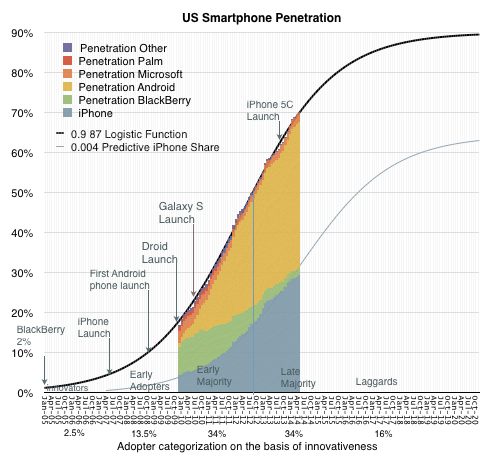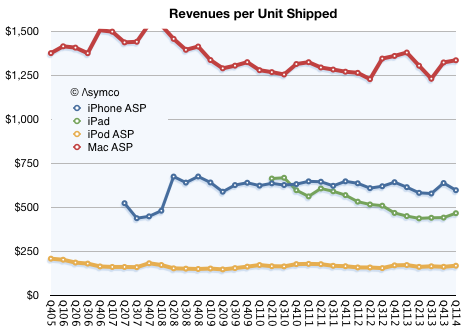The spread of smartphones: what does the market do to attract the “later majority”?
 Seven years after the launch of the iPhone, the number of smartphone users in the United States reached 70% of the country's total population. Smartphones existed before the iPhone, so this category of products is clearly more than seven years. However, given the number of current users, we can already say that this is the fastest process by which a new category of products has been adopted in the history of the population.
Seven years after the launch of the iPhone, the number of smartphone users in the United States reached 70% of the country's total population. Smartphones existed before the iPhone, so this category of products is clearly more than seven years. However, given the number of current users, we can already say that this is the fastest process by which a new category of products has been adopted in the history of the population.Over the same seven years, the CD player reached 55% of the population, and the boombox - 62%. If you measure the period during which the penetration of smartphones in the United States will increase from 9% to 90% [1], then its duration will be approximately 9 years, starting in 2008. Until 2008, the product was, for the most part, experimental, and the manufacturers participating in this experiment [2] mostly failed. After the voiced period of 9 years, the overwhelming majority of products will become “widely available and interchangeable”, while the profitability of products will begin to decline, and the consolidation of production around major vendors will increase.
The audience growth rate is even more impressive when you consider that penetration occurs at the individual level, not at the household level. Consequently, the total number of users is over 270 million, whereas usually consumer technologies target 115 million users [ this is an indicator of consumer technology penetration among the US population in absolute terms - approx. trans.]. Thus, in the case of smartphones, almost 60% more purchases are made. It is also noteworthy that this product has a shorter life cycle (2 years) compared with other technological products for consumers [3].
')

Given the above, the US smartphone market is now in the process of being spread among the “Late Majority” (conservatives). No wonder. The inflection point of the life cycle curve dates back to mid-2012, which suggests that the market has been in the current phase for 2 years. It is possible that this period of growth slowdown may last another 2 years.
According to Geoffrey Moore, approaches to the sale of goods should be selected depending on the current stage of market development. In the case of sales to innovators (the first 2.5% of users) it is worth focusing on the very novelty of the product. Early followers (the next 13.5%) are looking for product exclusivity and the opportunity to show their financial status in society. For the early majority (34%), it is important that the product is recognized by others, and the later majority (34%) need an increase in productivity when using the product. For skeptics (the last 16% of users) it is important to make a safe choice.
One of the misconceptions about the life cycle of making a product is related to the importance of its price. It is believed that the price of a product becomes more and more significant as society adopts technology. In fact, the price always has a high value, so this value can be leveled. Pricing is only one of the components of marketing, and at any time [on the market - approx. transl.] there are solutions in different ranges of the price spectrum. Pricing can, in addition, serve as a factor in intentional confusion because of the possibility of package product offerings and, conversely, the fragmentation of solutions into several products.
As an example, Apple’s attitude to its products in the later stages of the life cycle. Products of this company are known for their well-established pricing.

Revenue from sales of one Mac, iPod, iPhone, and iPad unit stubbornly remains stable. This does not mean that devices are sold at a fixed price. The company is constantly changing the ratio of the number of products of medium, low and high class to keep the average retail price constant. Essentially, the averages remain unchanged, which in turn means that, regardless of the current market stage, Apple's profitability remains unchanged.
So, if we look at the remaining 2 years of smartphone penetration growth, how will Apple do?
There is some indirect evidence that the company will be doing quite well. In search of any leads, I analyzed two data sets: the rate of replenishment of the audience by new smartphone users (person / month) in relation to new iPhone or Android users.

Note: The title of the second chart should be as follows: “The number of new smartphone users in the United States per week (in the context of approximately three months)”
I'm trying to find a connection between the speed of adoption of a product (smartphone) by the public and the speed of distribution of the iPhone. When analyzing new smartphone users, I took into account the quantitative change in the user base (in the context of several weeks), and also used the user's choice in favor of the iPhone as a growth differential. [4] There is no noticeable relationship between the speed of distribution of the product and preferences in favor of a particular platform is not traced. However, with a more detailed analysis, you can see outbreaks of the influx of new users, especially starting in 2012.
The numbers differ quite significantly: from ~ 300 thousand users per week, up to 1 million. Periods of surge, in which there is an increase in the number of users, may be a consequence of the launch of new products, and the result of shares of mobile operators. Anyway, there are deviations in one direction or the other.
If we look at the corresponding schedule of adoption of mobile platforms among users, then the ratio will be as follows: peak points are chosen in favor of Android, and depressions correspond to the choice in favor of the iPhone. This fact may seem quite logical: after the market saturation level reached 50%, the mobile operators “lure” with shares of the remaining potential consumers who are buying the cheaper products.
However, there is also something paradoxical about this data. Why, while the market is at the stage of saturation, the iPhone shows good results, although no one forces it to buy? Judging by the above graph, after exceeding the 70% threshold for adopting technology, the number of new iPhone users, compared with Android, increased by 1.4 million.
Even if you look at the statistics of the past 6 months, we will see that the number of iPhone users from the late majority increased by 15.5 million, while Android users increased by 14.2 million. Will iPhone figures be even better if the number of promotions for the “recent conservatives” and “skeptics” decreases?
The only thing that can be said is that cheapness is not the main engine of this market. Again, she was never him. Shortly before the appearance of the smartphone market, RAZR was the most popular phone in the United States. And it was a premium device.
Notes:
[1] I consider this period of growth “economically attractive”
[2] Palm, BlackBerry, Nokia
[3] for example, compared to televisions, refrigerators, radios, etc.
[4] iPhone audience growth minus Android audience growth (in millions of users). Positive figures indicate an increase in the rate of flow of new iPhone users. Negative indicators - an increase in the rate of flow of new Android users.
Source: https://habr.com/ru/post/241329/
All Articles